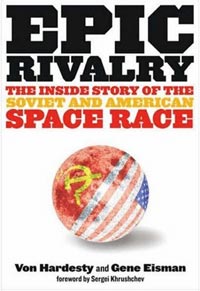Review: Epic Rivalryby Jeff Foust
|
| The subtitle of the book promises the “inside story” of the Space Race, but readers already with some familiarity with the history of that era, there are few new revelations. |
As the title suggests, Epic Rivalry focuses on the early heated competition between the US and the USSR, from 1957 through the Apollo 11 mission in 1969. (An epilogue hurriedly goes through American and Russian space efforts from 1969 to the present.) The book offers a fairly straightforward, chronological review of that era, as well as the events of the 1940s and 1950s that led up to the beginning of the Space Age. If there are central characters in the book, they are, unsurprisingly, Sergei Korolev and Wernher von Braun, supported by the other engineers, politicians, and astronauts and cosmonauts of that era. The chapters are separated by two- and four-page sidebars on technical topics ranging from orbital mechanics to the use, or lack thereof, of atomic propulsion. The book includes a good deal of black-and-white and color photography, some of which, particularly from Russia, has rarely, if ever, been published before.
The subtitle of the book promises the “inside story” of the Space Race, but readers already with some familiarity with the history of that era, there are few new revelations. That may be because the book relies heavily on secondary sources, including other books and articles (including several articles from this publication); the book’s endnotes reveal few historical documents or other primary sources, including interviews. One exception is the book’s foreword, written by Sergei Khrushchev, son of Nikita and himself an engineer who worked for a time on the Soviet space program. His insider’s point of view offers, in that brief section of the book, an interesting look at the early Soviet space program and its internecine battles; at one point, Khrushchev describes Korolev as doing “what he did best—the elimination of his rivals.”
By itself, there is little to fault Epic Rivalry: the text offers a good overview of the history of the Space Race between the US and USSR, and the photos complement the book well. The only disappointment is for those already familiar with the basic history of that era and looking for new details, or that inside story the book promised: there are few new insights, and certainly no history-reshaping revelations, to be found here. Undoubtedly the last word has yet to be written about the Space Race in general, or its origins in particular, but now, thanks to the recent crop of books like Epic Rivalry, the story is looking very familiar.
